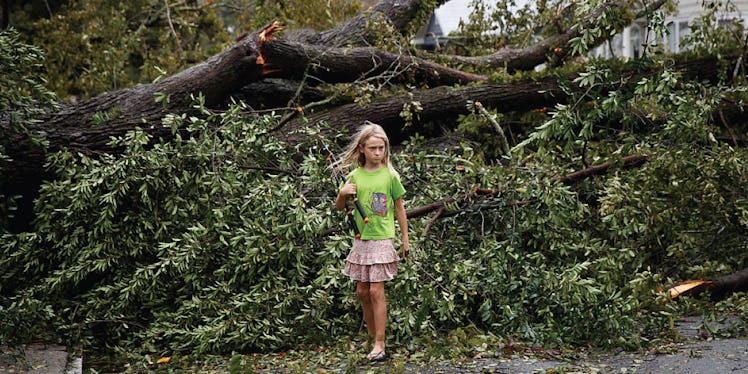Emergency Action Plan: 5 Simple Steps Kids Can Follow In An Emergency
Life doesn't always go according to plan — but that doesn't mean your family shouldn't have a plan.

As a parent, you’re constantly looking for ways to analyze and minimize (not to mention sanitize and deodorize) risks in your kid’s life. Everyone appreciates the effort, but the odds say there will be situations that are out of your control. There are natural disasters. Man-made disasters. Medical emergencies. Perhaps you just live in Florida. The point is, your kid needs to know what qualifies as an emergency, what doesn’t, and what the family’s plan is, just in case.
Dr. Sanam Hafeez is a New York-based psychologist who specializes on working with kids and their families. She’s heard about the panic that usually ensues when the Play-Doh hits the fan, so she came up with some rock-solid advice on what kids can do in a crisis. Hopefully, there won’t be a “what’s the number for 911?” moment if there’s a real emergency.
RELATED: A Pitiful Portion of America’s Disaster Budget Goes to Children
“Emergency” Is Relative
There’s an important lesson to be learned from that woman who threw a fit in the McDonald’s drive-thru: Not everything is an emergency. Dr. Hafeez says the first step is teaching your kid to recognize this. “Your child could literally be in an emergency and not realize it,” she says. And Dr. Hafeez knows from personal experience. “When I was 8 years old, my house caught fire. And I was in my room reading a book. I had no idea what was happening,” she says. “My sister came and got me, and I still didn’t quite understand — no one had ever really spoken to us about an emergency, and I said to my sister, ‘Oh, I think I should get my bike.’ I was a bright kid and my parents were very hands-on, but it just goes to show you kids don’t understand the devastation something like a fire can cause.”
Conversely, not everything they see as a “crisis” is actually an emergency. G.I. Joe’s leg goes missing: Not an emergency. Your leg goes missing: Emergency! Dr. Hafeez recommends explaining it like this: “An emergency is something very serious or very dangerous, like if mommy or daddy is hurt and can’t get to the phone, or you’re alone and no one can come to you for help, or someone’s trying to break in the door or there are bad people in the house,” she says. Go ahead and give them a range of scenarios, but remember they’re designed to teach, not terrify.
911 Isn’t A Joke
Great, so your leg fell off and your kid now know it’s an emergency. Next step: Make sure they know where the phone (mobile and/or landline) is and how to dial 9-1-1. This may seem unnecessary in the age of the iPhone, but they should memorize numbers for emergency responders and neighbors they can go to for help.
Dr. Hafeez says they can practice dialing on a toy phone — although you might get swatted by PAW Patrol . Talk about what information they’ll need to provide: 1) Where they are. 2) Who they’re with. 3) What’s happening. Also, emphasize that it’s important for them follow any instructions the operator gives them. “Parents are always telling their children ‘Don’t listen to anyone else,’ but they should listen to that person,” says Dr. Hafeez. Stranger danger doesn’t apply to the paramedic.
Flickr / CalEMAPhotos
Give Kids Detailed Emergency Plan Instructions
Covering your eyes with your hands may have seemed like a good plan when you were 5, but you now know you’re not actually invisible. “Your child doesn’t know what ‘Go to a safe place’ means,” Dr. Hafeez explains. She says you need to give kids clear, specific tips based on what’s likely in their environment. At school, they need to find a teacher or hide under a desk. In an earthquake or hurricane they need to pick a spot where there won’t be shelves overhead that could fall on them. And, if it’s general home safety, be clear about which exit routes are safe to take if there’s a fire. (Jumping out of high windows only works for John McClain).
Flickr / Rennett Stowe
Role Play Emergencies & Natural Disasters
Like Daniel Day-Lewis, sometimes you need to go Method. Acting out emergency scenarios and challenging kids to problem-solve their way through them will make sure they can execute when the time comes. “Practice things like, ‘If there was a fire in this room what door would you go out from? What problems might you run into? If you can’t find mom, which neighbor would you go to?’,” says Dr. Hafeez. If they say ‘Daniel Tiger’s house!’ you might need to workshop this a bit more.
Don’t Freak Kids Out
There’s such a thing as being over-prepared. “I think parents have to be so careful about how they approach children,” says Dr. Hafeez. “You have to prepare your kids for emergencies, but there are some parents who are so anxious and neurotic that without meaning to, they pass that onto their kids. If you’re constantly making them hyper-vigilant, they don’t learn what they’ll need in a real emergency to navigate it themselves.” Trust that even they don’t have your evacuation plan committed to memory, their fight-or-flight response will kick in and hopefully get them to safety. So, split the difference. Fire drills should be once a month, not once a night.
This article was originally published on